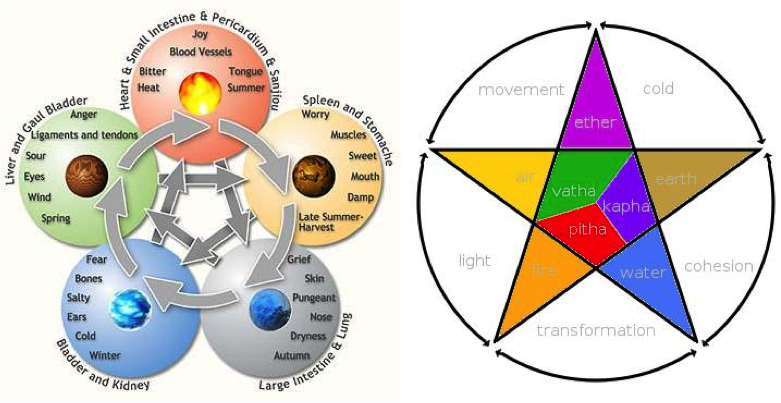Ayurveda has not only migrated from the East to the West, it has even casually made its way onto grocery and drug store aisles. Imagine my delight upon seeing neem, guduchi, triphala and several other ayurvedic herbs lining the top row at my local grocery store! Without a moment’s hesitation, I bought two bottles of ashwagandha, planning to have it with warm milk and nutmeg to calm my high vata and get a good night’s sleep. I did wonder, though, how the average person would know what herbs are good for their particular dosha imbalances? Or what dosha even means?! According to Ayurveda, the principle of Tridosha Theory, which describes vata, pitta, and kapha doshas, began thousands of years ago during the formation of the universe, in the black, stillness of the cosmos. Hold on, and I will explain…
In this ether, unmanifested consciousness or Purisha existed. Slight vibrations in the air gave birth to the sacred sound of Aum, or Shakti. From the friction of air waves, fire emerged. Heat from the fire condensed and formed into droplets of water. Finally, the water dried, and the residue became the earth element. These are the five great elements (Panchamahabhoota), of which everything in the universe is made; from the tiniest atom to the great mountains, and all living and non-living universal matter, including you and me!
Now, we can connect the dots between the Panchamahabhoota and the tridoshas. The word dosha refers to how the five basic elements are grouped into the principles of vata, pitta and kapha. Vata consists of air + ether, pitta, of fire + water and kapha, of water + earth. Each being has different amounts of vata, pitta and kapha that make-up their unique psycho-physiologic state. It’s common for a person to have one or two predominant doshas.
Vata governs all bodily movements (nervous + skeletomuscular systems), pitta oversees metabolism (digestion, enzymes, and hormones) and kapha is responsible for lubrication and structure of the body (grounding and stability). Of course, this is just a little taste of the doshas. To find out more about the doshas and what your doshic state is, see Table 1 below. Are you vata/pitta with a little kapha? Kapha/pitta with a little vata? Or are you pitta predominant?

Emotions, thoughts, actions and personality are all influenced by the doshas. Seasons, time of day, and foods also affect them. I happen to be vata predominant, with pitta a close second. In the cold, dry of wintertime, my vata is definitely vitiated and high. Add to that the anxiety and worry dominating our current world, and it’s no wonder I’ve been having attacks of anxiety! To help lower my vata and bring it back into alignment, I took time one day to massage my body with oil and took a hot shower after soaking for 30 minutes. I ate fresh ginger and turmeric followed by hot water to bring heat into my body. I’ve also been eating a handful of nuts at vata time (2 to 6pm), yams, avocados and wheat to give strength to my body. Finally, I make sure to cover my head, ears and body from the cold and wind when I walk the dogs and go outside. All of this helped ground me immensely.
Similarly, if kapha is vitiated and excessive, then eating foods that are light, easy to digest but also pungent (spicy), bitter, and astringent can bring it back into balance (cooked kale, bittergourd, barley). Avoiding humidity, skipping breakfast, and eating the biggest meal at mid-day can also re-align kapha. If pitta is in excess, it can be normalized by avoiding overly spicy, sour and salty foods and consuming foods with a cooling effect (such as cilantro, coconut water, fresh ginger). It’s also important to stay hydrated and cool on hot, summer days to keep pitta from going haywire.
To sum up, living beings are a microcosm of the universal macrocosm. Just as all universal matter consists of the five elements, so does everything on earth. When in a natural state of balance, each living organism lives harmoniously with its surroundings. When out of balance, the doshas become vitiated (toxic) and illnesses may manifest. Ayurveda seeks to treat and prevent disease by rebalancing doshas, starting at the root of the problem, with our everyday eating and living habits. Understanding the doshas and the elements they come from can promote self-care and healing in ourselves and others. Wishing you much love on your journey toward health!
Uma Hingorani
Ayurvedic Practitioner, Ashoka Holistic Ayurveda, LLC
References:
1. Diagnosis by Ayurveda, Treatment by Chinese Medicine | World Vitae
2. Lad, Vasant. The Textbook of Ayurveda, Volume One. The Ayurvedic Press: Albuquerque, 2002
3. Ever heard of Vata, Pitta and Kapha? | The Blue Planet For The Home Sweet Homers (wordpress.com)




